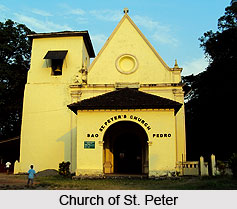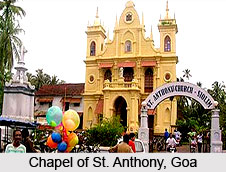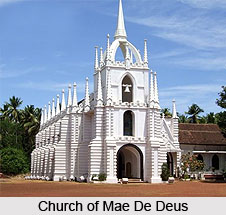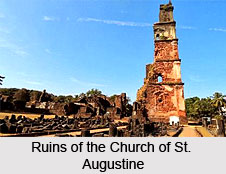 Goa has some world famous churches and convents and the most comprehensive group of churches and cathedrals built during 16th and 17th century AD at Old Goa and are a legacy of the Portuguese. The famous churches of old Goa comprises of Se` Cathedral, Church and Convent of St. Francis of Assisi, Chapel of St. Catherine, Basilica of Bom Jesus, Church of Lady of Rosary, the Church of St Augustine and the Church of St. Cajetan. These monuments were influential in spreading forms of Manueline, Mannerist and Baroque art in all the countries of Asia where missions were established.
Goa has some world famous churches and convents and the most comprehensive group of churches and cathedrals built during 16th and 17th century AD at Old Goa and are a legacy of the Portuguese. The famous churches of old Goa comprises of Se` Cathedral, Church and Convent of St. Francis of Assisi, Chapel of St. Catherine, Basilica of Bom Jesus, Church of Lady of Rosary, the Church of St Augustine and the Church of St. Cajetan. These monuments were influential in spreading forms of Manueline, Mannerist and Baroque art in all the countries of Asia where missions were established.
The churches display a combination of the Renaissance and Baroque styles. They are generally built of laterite and lime plaster. The paintings in the churches were done on wooden borders and fixed between panels having floral designs as in the chapels housing the tomb of St. Xavier, the arches above the altars in the transept of the Se` Cathedral and in the nave on either side of the main altar in the Church of St. Francis of Assisi. Excepting a few which are in stone, the statues are mostly in wood delicately carved and painted to adorn the altars. They depict mostly the saints, Mother Mary and Jesus on the cross.

The Basilica of Bom Jesus:The name Bom Jesus basically means "good Jesus" or "infant Jesus". The Basilica of Bom Jesus or Basilica of Bom Jesu is located in Goa. The church is located in Old Goa, which was the capital of Goa in the early days of Portuguese rule, about 10km from the city of Panjim. Close to the convent of St Francis, the 1605 church of Bom Jesus is known principally for the tomb and the mortal remains of St Francis Xavier, a member of the Society of Jesus, who came to India with the Portuguese to spread Christianity in India.
Se Cathedral: One of the oldest and most celebrated religious buildings in Goa, the Se cathedral is one of the largest churches in Asia and it took eighty years to get completed. It is dedicated to Catherine of Alexandria and is located in Old Goa. This monument truly represents the royalty of Goa in the early days, during the rule of Portuguese. One of the most sacred buildings for the Christians, Se cathedral has been declared a heritage site by UNESCO.
Church of St. Francis Of Assisi: Church of St. Francis of Assisi is situated to the west of Se Cathedral in the Convent of St. Francis of Assisi. It was initially a chapel and modified into a church in 1521 AD, dedicated to the Holy Spirit on 2nd August 1602.
 The convent was made by the Franciscan mendicants as their residence and underwent alterations in 1559 AD. The Portuguese government closed the convent in 1835 AD. The Archaeological Survey of India has converted the church into a museum in 1964. The church displays artifacts, paintings and pieces of Hindu temple sculptures from Goa.
The convent was made by the Franciscan mendicants as their residence and underwent alterations in 1559 AD. The Portuguese government closed the convent in 1835 AD. The Archaeological Survey of India has converted the church into a museum in 1964. The church displays artifacts, paintings and pieces of Hindu temple sculptures from Goa.
The architecture is a combination of the Tuscan style from the exterior and the Mosaic-Corinthian style from the interior. The interior of the church is gilded with the scenes from the Bible and wall frescoes show intricate floral designs. The niche of the facade holds the statue of St Michael and a wooden statue of St Francis Assisi decorates the pedestal in one of its chapel. A heavily carved niche with tabernacle supported by four evangelists can be seen in the main altar. Two huge statues, one of St Francis Assisi and the other of the Jesus on the Cross- are placed above the tabernacle.
Church of Lady of Rosary: The Church of Lady of Rosary stands on the top of the western side of the Holy hill or Monte Santo overlooking the Mandovi River and Divar Island. This is supposedly the very place where Alfonso de Albuquerque led his troops to victory in 1510 AD and a plaque was placed with the inscription in the 1950`s. Its status was raised to a church in 1543 AD and it was entrusted to the care of the Franciscans. The people held it in great reverence as St. Francis Xavier used to teach catechism here every evening to the public who flocked together at the sound of a little bell he rang.
 The facade of the church appears like a fortress openings in its wall to look out for the invaders. The design is simple. The tombstone of Garcia de Sa, one of the earlier Governors of Goa lies in front of the altar. It is a fine example of true "Manueline" style architecture of the early Portuguese. Its interior is simple and has five altars. The main altar bears the image of Nossa Senhora de Rozario or Our Lady of the Rosary.
The facade of the church appears like a fortress openings in its wall to look out for the invaders. The design is simple. The tombstone of Garcia de Sa, one of the earlier Governors of Goa lies in front of the altar. It is a fine example of true "Manueline" style architecture of the early Portuguese. Its interior is simple and has five altars. The main altar bears the image of Nossa Senhora de Rozario or Our Lady of the Rosary.
Church of St. Augustine: 12 Augustian friars constructed the convent in 1572 AD immediately after their arrival at Goa on 3rd September 1572. The church was constructed in1602 AD. Both the church and the convent are in ruins. The church was in good condition till 1835 AD when it was abandoned because of the ban on the religious orders by the Portuguese government. The vault of the church collapsed in 1842 AD, whereas the facade collapsed on 8th and 19th August 1931. Only the bell tower without the bell is left today. The bell was taken to the Fort Aguada Light House initially from 1841-71 AD. In 1871 AD, it was moved to the church of Our Lady of Immaculate Conception at Panaji where it is functioning even today.











